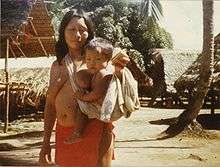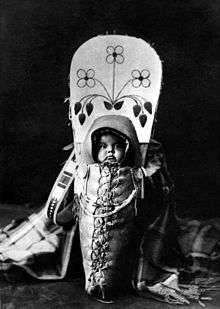Babywearing

Babywearing is the practice of wearing or carrying a baby in a sling or in another form of carrier. Babywearing has been practiced for centuries around the world. In the industrialized world, babywearing has gained popularity in recent decades. Part of the reason for this shift is due to the influence of advocates of attachment parenting. Babywearing is a form of baby transport which can be enjoyed for as long as mutually desired, often until toddlerhood and beyond .[1]

Benefits
Dr. William Sears, a pediatrician, coined the phrase attachment parenting. One of Sears' principles of attachment parenting is babywearing and he attributes many benefits to babywearing and the in-arms style of parenting.
The benefits of babywearing include:
- In the wearing of newborns in particular, the mothers' oxytocin levels are increased through the physical contact with the infant, leading to a more intimate maternal bond, easier breastfeeding and better care, thus lowering the incidence of postpartum depression and psychosomatic illness in the mother;[2] similarly, the father carrying the baby has benefits for the paternal bond.
- Infants who are carried are generally calmer because all of their primal/survival needs are met. The caregiver can be seen, heard, smelled, touched, tasted, provide feeding and the motion necessary for continuing neural development, gastrointestinal and respiratory health and to establish balance (inner ear development) and muscle tone is constant.[3]
- Parental rhythms (walking, heartbeat, etc.) can have balancing and soothing effects on infants.
- Infants are "humanized" earlier by developing socially. Babies are closer to people and can study facial expressions, learn languages faster and be familiar with body language.[4]
- Independence is established earlier.[3]
- Attachment between child and caregiver is more secure.[5]
- Decreases risk of positional plagiocephaly ("flat head syndrome") caused by extended time spent in a car seat and by sleeping on the back. Cranial distortion resulting from non-vehicular time in car seats has shown to be more severe than in children who develop plagiocephaly from back-lying on a mattress.[6] Concern over plagiocephaly has also led the American Academy of Pediatrics to recommend that infants “should spend minimal time in car seats (when not a passenger in a vehicle) or other seating that maintains supine positioning."[7] None of the babywearing positions require infants to lie supine while being carried. Infants can even be worn while they sleep, also decreasing sleeping time spent in a supine position.
Studies of parent-child attachment, parental satisfaction and infant crying all point to babywearing as an ideal solution for parents to provide an optimum environment for attachment between parent and child. Baby carriers and slings help increase the number of hours a day an infant is held, and there is an inverse relationship between the number of hours spent crying and the number of hours a child is held in a given day. Even three hours per day of babywearing reduces infant crying significantly, and at 13 months, babies who have been in soft carriers regularly are significantly more likely to be securely attached than babies who are carried in hard carriers.[8]
Practicality

Babywearing allows the wearer to have two free hands to accomplish tasks such as laundry while caring for the baby's need to be held or be breastfed. Babywearing offers a safer alternative to placing a car seat on top of a shopping cart. It also allows children to be involved in social interactions and to see their surroundings as an adult would.[1]
It follows that many sling and soft carrier users have found that carrying their infant is much easier on the back and shoulders than lugging them in a car seat. The weight of the child is spread more evenly across the upper body and they don't have to struggle with a bulky, hard and awkward car seat.[1]
There are many different types of carriers available to purchase or swap, and they can also easily and cheaply be made by the parent or caregiver, also laws in the United States have now limited the legality of manufacturing carriers and slings. Wraps, slings, mei tais, and soft structured carriers with buckles (also referred to as SSCs)make up the vast majority of carriers. In the western world, carriers can also be seen as a fashion statement and be worn as part of an outfit. They come in many different designs and colors and are available in many different types of fabrics from specialist manufacturers, including bamboo, silk, hemp, cotton, wool, fleece, flax/linen and more recently some synthetic blends such as Repreve and Tencel.[1]
Infant feeding and babywearing
Breastfeeding and babywearing often go hand in hand. Many baby slings and other carriers offer mothers privacy and for many mothers, the option of nursing hands-free while tending to other activities or household chores. Not all mothers can nurse hands-free in a baby carrier. Large-breasted mothers and mothers of small or hypotonic infants may need to support the breast or help maintain proper positioning of the baby's head or body. Even so, a properly adjusted baby carrier can help reduce arm strain and allow a mother more freedom of movement while nursing, even if it does not allow her to be completely hands-free.[1]
Babywearing can help premature babies and babies who are slow weight gainers to gain weight at a faster rate.[9][10] Since the baby is held up close to the mother, the baby will be able to be nursed more often and often for longer intervals. Kangaroo care is well-studied and has shown clear benefits to premature and ill infants.[4]
Not all parents find breastfeeding in a sling or carrier easy. It is important, before attempting to breastfeed in a carrier, to first master the art of breastfeeding without a carrier. Latch and position are vital, and it is important to establish these first before adding a carrier to the mix. Where breastfeeding difficulties exist, babywearing can simplify the other tasks of parenting by allowing a parent free hands to deal with breastpumps, bottles and other supplementation devices.[11]
Some parents prefer, even with the best carriers, to take time out and sit down to nurse a baby. Some babies may reflexively clamp down when nursing while a parent moves around, so nursing while babywearing is not always entirely comfortable. Individual experience will vary radically not only from parent to parent, but also from baby to baby, even within the same family. Some babies nurse very well in slings and carriers, others do not.
Where breastfeeding is not possible, babywearing can aid attachment by encouraging closeness during bottle feeding. Daycare providers and foster parents often find that babywearing allows them to better meet the needs of multiple children by freeing hands during times when babies need to be held.[1] It is possible to wear two children at once; this is known as tandem babywearing. This can be done with twins or with two children of different ages, for all the reasons of practicality and enjoyment stated above.
Celebrations
Babywearing is celebrated around the world each year during the annual International Babywearing Week. Many countries have formed their own celebrations that run alongside this event such as Australian Babywearing Week. and New Zealand Babywearing Week There are also several babywearing conferences such as WEAR and IBC.
Safety
As with any physical activity, there are certain safety precautions which must be considered in babywearing. Most are common sense, but the guidelines are particularly important to remember when carrying a newborn baby that has limited head control. The acronym TICKS [12] was created to assist with remembering the safety basics of babywearing:
- Tight
- In view
- Close enough to kiss
- Keep chin off the chest
- Supported back
The question has been raised as to whether or not babywearing is safe with respect to falls. In the case of a caregiver accidentally tripping or falling while wearing a baby, the wearer's arms would likely be free to break the fall, while the child remained relatively safe close to the carer's centre of gravity. If the child was being carried 'in arms' without a carrier, the likelihood of injury would be much higher due to the impossibility of the carer being able to both hold the child safely and protect themselves from injury. .
Further reading on the subject of babywearing safety can be widely found.[13][14]
See also
Popular Carrier Types
- Wraps
- Ring Slings
The ring sling easily adapts to fit the carrier and baby comfortably. It is a long piece of material that has 2 rings on one end. The other end is then strung through the rings, creating a "seat" for the child. Depending on the material used, they can be used from birth through toddler years. Ring slings typically identify a particular weight that the fabric can hold.
- Soft Structured Buckle
This Buckle Carrier, as it is commonly referred to, is similar to the Mei Tei carrier. It differs in that instead of being tied, it has buckles that attach to the cloth which allows for tightening of the carrier. The child can be worn on the front of the back. There are different sizes of Soft Structured Buckle carriers including standard, toddler, and preschool. The individual brand of carrier specifies the weight limit that it can hold.
- Mei Tei
References
- 1 2 3 4 5 6 Blois, M, MD. (2005). Babywearing: The Benefits and Beauty of This Ancient Tradition. Pharmasoft Publishing.
- ↑ ""Regulation of anxiety during the postpartum period"", Lonstein, Joseph S., Frontiers in Neuroendocrinology, Volume 28, Issues 2-3, August–September 2007, Accessed 2009-05-09
- 1 2 Morris, D. (1992). What Comforts a Baby? In Babywatching (pp 80-82). New York: Crown Publishers Inc.
- 1 2 Kitzinger, Sheila. (1989). The Crying Baby. Penguin Books.
- ↑ Anisfeld, E., Casper, V., Nozyce, M., & Cunningham, N. (Oct., 1990). Does Infant Carrying Promote Attachment? An Experimental Study of the Effects of Increased Physical Contact on the Development of Attachment. Child Development, Vol. 61, No. 5, 1617-1627.
- ↑ Littlefield, Timothy R. "Car Seats, Infant Carriers, and Swings: Their Role in Deformational Plagiocephaly," Journal of Prosthetics & Orthotics 15, no. 3 (2003): 102-106.
- ↑ John Persing, MD, et al., American Academy of Pediatrics Committee on Practice and Ambulatory Medicine, Section on Plastic Surgery and Section on Neurological Surgery, "Prevention and Management of Positional Skull Deformities in Infants," Pediatrics 112, no. 1 (July 2003): 199-202..
- ↑ Klaus, M., Kennell, J., Klause, P: Bonding, pp 126,204-5. Addison Wesley Publishing Company, 1995.
- ↑ Hasselmeyer, E. G. (1964). The premature neonate's response to handling. Journal of the American Nursing Association, I. 15-24.
- ↑ Solkoff, N, et al. (1969). Effects of handling on the subsequent development of premature infants. Developmental Psychology, 1(6). 765-768.
- ↑ "Breastfeeding in a Carrier", TheBabywearer.com Wiki.
- ↑ http://www.schoolofbabywearing.com/Images/TICKS.pdf
- ↑ http://babywearinginternational.org/pages/safety.php
- ↑ http://babywearinginternational.org/pages/InfantSlingSafety.php
External links
Baby wearing at DMOZ
- Babywearing UK
- Baby wearing video showing safety and different techniques
- Sling babies - NZ not for profit support group
- Baby Carriers - reviews, ratings, comparison
| Wikimedia Commons has media related to Baby sling. |